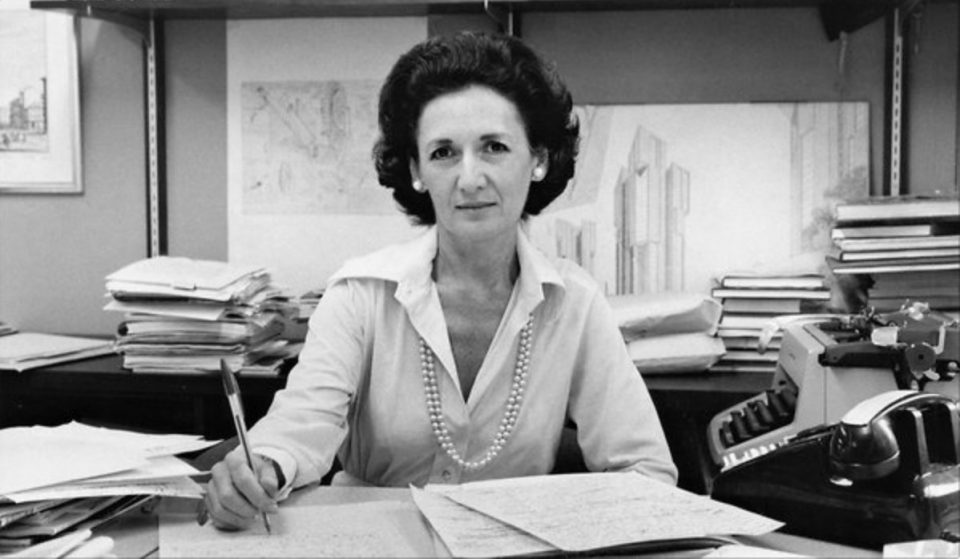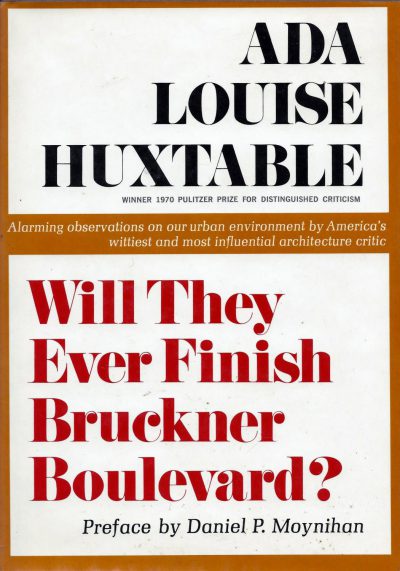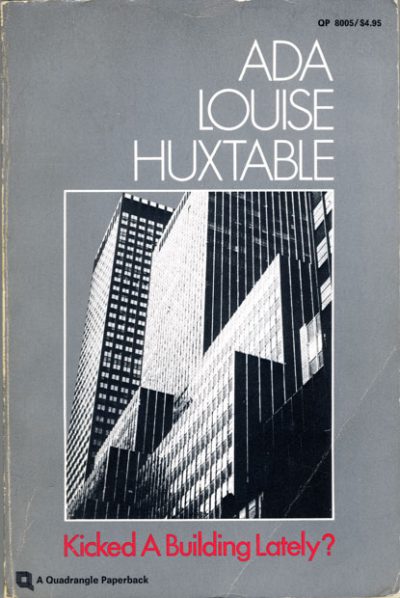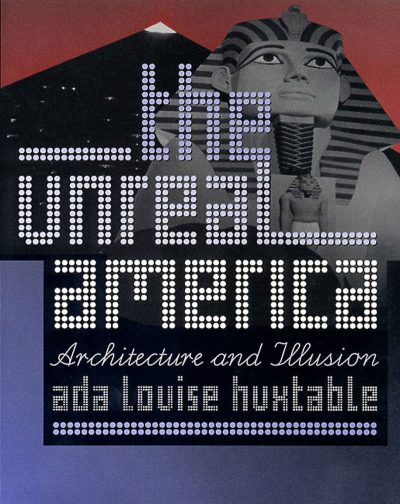Ada Louise Huxtable (1921–2013) was one of the most powerful voices in architecture in the latter half of the twentieth century. As architecture critic of The New York Times in the 1960s and ’70s, she carried enormous weight, securing or sinking many an architectural reputation, christening or thwarting many a project, and shaping the tastes and values of the public throughout the United States. She was the first woman named to the jury of experts for the distinguished Pritzker Architecture Prize, on which she served from 1987 to 2005. Her thunderous prose resonated loudly through the cavernous canyons of New York City: crisp, hard-hitting, but elegant, lucid prose that stirred admiration, contempt, and sometimes just plain awareness of buildings she thought significant. Architects, developers, and city officials practically quaked in anticipation of her verdicts. In 1968, early on in her journalistic career (though her name was already well known), a cartoon in The New Yorker depicted two construction workers poring over blueprints, one of them commenting, “Huxtable already doesn’t like it.” Frank Gehry, at her memorial, said much the same: “Even though I wished for her attention, I was scared of it. . . . She was tough, but her words were beautiful.”
She never minced them. Words like “shoddy,” “half-baked,” and “spineless” were part of her style, contributing considerably to her success. Her texts showed a love of alliteration, an awareness of rhythm and cadence, and the need for an attention-snapping, knockout punch line; typically, too, her writings bore a deeper, fundamental truth. She wrote naturally, without contrivance, choosing her words carefully and using them sparingly, preferring the short and simple to the multisyllabic and verbose—a disciple here as elsewhere of Mies’s “Less is More.” She said much with little, loved writing, and did it with flair.
But writing was only a tool. Her passion was architecture and the urban environment, particularly that of New York City. Although she wrote on other things—architects, buildings, other cities—Manhattan was her favored terrain.
Early Life and Education
Born in 1921 and raised on the Upper West Side, she grew up an only child in a comfortable, middle-class Jewish family. Her father, Michael Landman, was a doctor, and her mother an exacting woman with a cultivated eye. They lived in a stately 1906 Beaux-Arts apartment building facing Central Park. She loved roaming the streets on her own, routinely crossing the park to visit the Metropolitan Museum of Art and other cultural institutions on the East Side. These outings proved invaluable, providing her an opportunity to see and absorb not only the buildings lining the streets of the city but also the ordinary human activities that gave them their vitality.
She stayed in the city for college, attending Hunter College, City University of New York, where she majored in art. After graduating magna cum laude in 1941, she worked at Bloomingdale’s in the furnishings department, where she met her husband, an industrial designer, Garth Huxtable, whom she married the following year. She pursued graduate work intermittently, taking courses in art and architectural history at the Institute of Fine Arts, New York University, but left without getting a degree because, according to Huxtable, her proposed thesis topic, “Modernism in Italian Postwar Architecture,” was rejected. This choice of topic was telling, not only of her determination to define her own direction, but also of her interest in seeking out new, unexplored areas of study. It may have been here, too, that she developed the disdain for the pretentions of academia that she would later show.
Career
In 1946, she was given a job at the Museum of Modern Art in the department of architecture and design, then under Philip Johnson, whose quick intelligence, keen eye, and sharp wit she respected but whose convictions about architecture she soon found shallow. Assisting him on the Mies van der Rohe retrospective at MoMA in the fall of 1947, she learned a great deal—about modern architecture, connoisseurship, assessing quality in art, and how to address, educate, and inform the public simply and clearly, without condescension. It was here in particular that she developed the discerning eye and critical astuteness that were to serve her so well throughout her career.
In 1950, she received a Fulbright award to pursue her interest in postwar Italian architecture, then, in 1958, a Guggenheim grant to study structural developments in American architecture. Two years later, she wrote her first book, on the Italian engineer/architect Pier Luigi Nervi, part of a series of scholarly books published by George Braziller. This, too, was an invaluable experience, as it not only gave her a chance to prove her writing skills but also provided her with an opportunity to understand and appreciate the structural logic of building that she believed basic to good architecture. The following year, she was asked to write a guidebook on modern architecture in New York City. By this time, her own definition of architecture was clear: aesthetics were essential but only part of the equation. Although she recognized the beauty of new constructions such as the Seagram Building and Lever House, she criticized the Pan Am Building (later, MetLife) for the devastating effect the “behemoth-sized” structure would have on the scale of Park Avenue, and the burden its 25,000 daily office workers would have on the already overtaxed pedestrian and transportation facilities in the Grand Central Station area. A petite woman and still a fledgling in the field, Huxtable had no qualms about publicly chiding Walter Gropius, pioneering modernist then at the peak of his career and head of the Harvard Graduate School of Design, who had collaborated in its design, pointing out how its antisocial character directly contradicted his teachings.
She showed her fearlessness in a trenchant New York Times article on the Pan Am Building. In “Marvel or Monster? Grand Central City Is Mass Architecture,” she drew public attention to the huge tower, then the largest corporate office building in the world, that was going up almost directly on top of Grand Central Terminal to block the grand vista down Park Avenue, and boldly excoriated its developers and the city officials for allowing it to happen. An earlier essay on the “Rothscaping” of Park Avenue, her first in the Times, pointed out what the city was losing as the old, gracious boulevard lined by elegant masonry hotels and apartments was rapidly being transformed into a corridor of modernist office towers, a good many of them by Emery Roth & Sons, a firm known for its pragmatic approach to design and adherence to the bottom line. In her New York Times Magazine article “The Art We Cannot Afford to Ignore (But Do)” of 1958, she pointed out the profound effect architecture had in shaping the environment. Thus, Huxtable’s early essays set the tone and made clear her moral commitment to the common good and her definition of architecture as a social art that had an unequivocal impact on the lives of people and the city at large. These writings also prepared the way for her appointment as a full-time architecture critic in The New York Times, the first in a major American daily newspaper.
Her concern for quality in the built environment paralleled her growing campaign for preservation. Galvanized by the demolition of Penn Station (1963), despite her efforts and those of Philip Johnson, Architectural Forum editor Douglas Haskell, and, most famously, Jacqueline Kennedy, Huxtable’s work in preservation gained momentum with the publication of Classic New York: Georgian Gentility to Greek Elegance (1964), which gave her the opportunity to delve into the historical legacy of the city. Disillusionment with the growing preservation movement set in quickly, however, and by 1966 she was already voicing concern that the city was turning into a moribund museum filled with ersatz brand-new “old” or “reconstructed” buildings and phony look-alikes. Here lay the roots of her book, The Unreal America: Architecture and Illusion (1997), a diatribe against preservationists motivated by profit as well as against postmodernists, theme parks, shopping malls, and heritage market places, denouncing the fakery, illusion, and make-believe she found in them all.
As The New York Times architecture critic, Huxtable wrote scores of essays—on new buildings, proposed buildings, bad buildings, threatened buildings, as well as on emerging architects, fresh trends, fashions, or movements, and architectural exhibitions—whatever topics she found significant. Her aims were consistent: to call attention to and inform the public about what was happening in its built environment, the public sphere. Her standards were exacting. Grounded in painstaking research, and informed not just by matters architectural but also real estate, developers, urbanism, local commercial interests, and, of course, politics, she backed up her views with solid fact and sound reasoning while voicing opinions she acknowledged were subjective.
In 1970, she received a Pulitzer Prize for her distinguished criticism, the first ever awarded to a writer in her field. Two years later, in recognition of her profound influence on city policy makers as well as on architects and developers, the Times elevated her to a member of the editorial board; she continued to write a Sunday column but, relieved from the pressures of a daily deadline, had time to publish two collections of her articles, Will They Ever Finish Brockner Boulevard? (1972) and Kicked a Building Lately? (1976).
In 1981, after close to two decades as a columnist for the Times, she received a MacArthur grant, which freed her to step down from the grueling day-to-day, deadline-driven pace of the daily newspaper and to address subjects of her choice in depth. While for the most part Huxtable was contemptuous of academics, a derision that grew scathing in the heyday of postmodernism—she found academic postmodernists’ prose especially turgid, verbose, incomprehensible, and at times simply silly—she had nevertheless envied the time a university position allowed scholars to conduct in-depth research. Huxtable’s own less pressured work schedule led to Tall Buildings Artistically Reconsidered, which traced the development of the skyscraper from its origins in the late nineteenth century to its postmodernist renditions. A decade and a half later saw the publication of The Unreal America, in which she voiced her concern for the turn architecture had taken toward postmodernism, a trend she found shallow, without substance, bogged down in fashionable literary theory and “seductively appealing revolutionary obscurantism,” and which she predicted would be short-lived. As ever, she was fearless about naming names, taking to task Philip Johnson, whom she saw as “master of the game, hands and pediments down”; Robert A. M. Stern, whom she called the “Ralph Lauren of architecture”; and Michael Graves, whom she regarded as a better artist than architect. The Unreal America pointed out the disturbing tendency among Americans to prefer the easier, cheaper, more accessible facsimile to the real thing, the cheap copy to reality itself. She saw as much more promising what she called the new architecture of Rafael Moneo, Alvaro Siza, Christian de Portzamparc, Tadao Ando—their names alone demonstrating her global interests. In their work, she saw exemplified the enduring values of architecture: form, space, and light, manipulated to create places that mattered as much for what they did as how they looked, places that provided that extra measure of dignity or delight, the “elevated sense of self” that the art of building can provide.
Approaching her eighties and recognizing that the world of architecture was changing, radically, yet again, she spent several years in the New York Public Library studying the use of the computer as a new design and production tool. This exploration led her back to an unfinished project on Frank Lloyd Wright that she had begun years earlier, as she became aware of parallels between Wright’s work and the most advanced computer-generated design of tech-savvy young architects. The result was a biography on Wright that delved into the heart of his genius, which she saw as comparable to innovations in the contemporary world of computer-assisted design, and explored the nature of creativity in the design process.
In her last book, On Architecture: Collected Reflections on a Century of Change (2008), Huxtable, modernist through and through, traced the transformation of modern architecture through a selection of her essays over the years that included those she wrote for The Wall Street Journal and The New York Review of Books. She had lived through modern architecture’s evolution, from its postwar rise to hegemony in the 1950s, its splintering in the ’60s, its collapse in ’70s and ’80s, and witnessed its reemergence as a new kind of modernism in the 1990s, now expanded and greatly enriched. Included was an especially poignant series of essays on the World Trade Center, the first written within days of September 11, the second, third, and fourth following what she saw as a debacle as the dreams and visions of memorial crumbled into a real estate grab-bag. In these later essays, her condemnation of city agencies—of the Port Authority of New York and New Jersey, and of New York developers who, in the face of the world-changing tragedy, clung to the bottom line—could not have been more fierce, nor her case for New Yorkers holding out for something better, more clear.
Her essay “Undertaking Its Destruction,” on the proposed restructuring of the New York Public Library, written a month before she died, was a plea to preserve the Beaux-Arts architectural masterpiece completed in 1911. The library’s stacks were slated for demolition, which she asserted would be a desecration. The essay is as much as anything a passionate outpouring of love for the city, and for the challenge Huxtable saw in making its rich architectural heritage an integral part of “its dynamic vitality and brutal beauty.” Evident in this essay is her appreciation of the ordinary and the utilitarian, as well as her awe of splendid architectural accomplishments and her respect not only for the city’s past and present but also for its future, to which she remained open, recognizing that change is part of the historical process. To Robert Venturi’s notion of “complexity and contradiction in architecture,” Huxtable would add continuity and change, all part of the living heritage of the present. This final essay addresses matters of quality in architecture, the elements that make a good building, especially those constructions that have proved their lasting worth by continued use. Most of all, the essay conveys her commitment to the city of New York, where she lived her entire ninety-one years. After reading her essays—including those that fend off the criticism heaped on modernist glass boxes that she saw as “the breathtaking essence of New York,” whose “soaring, faceted, reflective mass gives the city both its hard-edged brilliance and its powerful poetry”—one cannot walk the streets of New York the same way again.
As Paul Goldberger, her successor at the Times, so simply and eloquently put it, she made architecture matter to us all.





